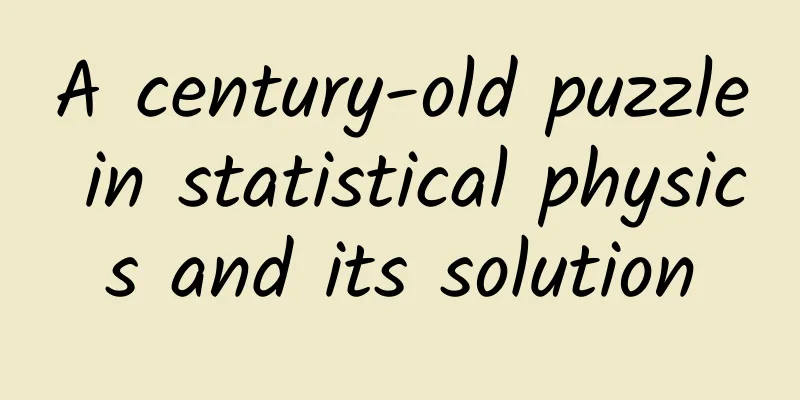A century-old puzzle in statistical physics and its solution

|
The new theory can not only give the results that have been established in experiments, but also predict new results. The physical rationality and ingenuity of this result can only be attributed to the arrangement of nature. Written by Liu Quanhui (PhD in Theoretical Physics, Professor of the School of Physics and Microelectronics Science, Hunan University) There is a big difference between difficult physics problems and difficult mathematics problems. It is not uncommon to encounter century-old mathematical problems. For example, it took 358 years from the proposal to the proof of Fermat's Last Theorem; and 280 years for the Goldbach conjecture. Interestingly, solving a difficult mathematical problem is equivalent to killing the goose that lays the golden eggs. There are also century-old problems in physics, and solving them is equivalent to discovering a goose that lays the golden eggs. These problems range from small ones such as why the ice surface is slippery to large ones such as the structure of the universe and its evolution; complex ones such as climate change, and specific ones such as pigeons returning to their nests, etc. The finite size effect problem in this article is written in the physics textbook, and research papers have been published on it throughout history. It is a small problem between mathematics and physics. one Finite size effect problem Among all statistical distributions, finding the most probable one is the introductory knowledge of statistics. However, statistics is concerned with a large number of samples. Rare cases are not within the scope of statistics. Statistical physics also seeks the most probable distribution, but a system often comes into contact with a heat reservoir or a particle reservoir, and there may be only one particle in the system. In other words, in statistical physics, even if there is only one particle, there will be a distribution. Single-atom heat engines have been a research hotspot in recent years, dealing with the statistical distribution of only one particle. Conventional thermodynamics deals with systems with a large number of particles, which are mathematically treated as infinite particles. At the same time, the volume of the system must also be infinite, and the density of the number of particles remains unchanged, which is the so-called thermodynamic limit. At the other extreme of the thermodynamic limit is a small system, or a system with few particles, or a finite size system. The new effect that will appear here can be called a finite size effect, or a few particle effect. However, for more than a century and a half, hundreds of thousands of statistical physics scholars have been troubled by the following problem in their quest for the most probable distribution: the applicability of the relevant theory requires a large number of particles, and only when this condition is met can the statistical distribution be given with the help of mature mathematical tools. Of course, when the number of particles is large, these results are also correct and have been rigorously tested by experiments. So, when the number of particles is small, is there any distribution? What is the form of the distribution? Mathematically, this problem comes down to how to deal with the logarithm lnx! of a variable x and the product x! and its calculus, where the variable x can be understood as the number of particles, x=0,1,2,… For example, when x is between 1 and 10, it is a so-called small-particle system. In statistical physics, the following Stirling formula of lnx! is often used: lnx! ≈xlnx-x. This formula has very high accuracy when the value of x is very large. But when x is small, for example, when x is between 1 and 10, the accuracy of this formula is very poor. However, in physics, it can only be taken in this way, and one more or one less item will not work! The key reason is that only in this way can the extensiveness of the entropy of a thermodynamic system be guaranteed. If a more precise approximation is used, the extensiveness will inevitably be destroyed. In other words, if the final result given by the precise Stirling formula is correct, it should be the so-called few-particle effect or finite size effect, but it is likely to be wrong. When x is the number of particles, lnx! is a natural discrete function. An important purpose of using the approximate formula lnx!≈xlnx-x is to turn lnx! into a continuous function for calculus operations. However, when x is small, the accuracy of treating lnx! as a continuous function is very poor, and it can only be treated as a discrete function. At this time, the differential dlnx! of lnx! should be replaced by the difference Δlnx!. However, there are many definitions of the difference Δlnx!, for example, the first step difference Δlnx!= ln(x+1)!- lnx!=ln(x+1), the second step difference Δlnx!= ln(x)!- ln(x-1)!=ln(x), the first two steps of difference, the second two steps of difference, ..., central difference, eccentric difference, ... and so on. There are so many definitions, and the physical results given are different from each other. Choosing any one of them is equivalent to introducing a new hypothesis. Even so, the results given are likely to be unreliable. Therefore, when lnx! appears in statistical physics, strict processing is required in two places: one is the precise expression of lnx!, and the second is strict discrete calculus. two Find the most stable solution Physicists are no match for mathematicians in seeking an exact Stirling formula for the function lnx!. All they have to do is transfer the results discovered by mathematicians. So the problem is not whether to use the exact Stirling formula. The problem must lie in the function differential. After many attempts and failures, we finally found a narrow but ingenious way to solve this problem [1], and it does not require the use of the Stirling formula at all. Finding the most probable distribution in statistical physics can be understood as a process of finding variation. If you are on the right path, you will definitely encounter some "monsters". Let's use a simple example to illustrate this. Therefore, the post-difference solution is more stable. Give a reasonable explanation, it doesn't matter if it comes from mathematics or physics, as long as you can pick out the post-difference solution. Very few researchers will go this far and then, through a new physical principle, take the most stable solution as the true solution and eliminate the unreal solutions. However, even here, the physical problem has not been fundamentally solved. three A little math trick: asynchronous differencing After a little calculation, the results given by the new theory are divided into three parts. In the first part, when the number of particles is very large, the results completely return to the traditional results. This part of the results has been repeatedly tested by experiments. If the new theory cannot give the same results, the theory must be wrong. In the second part, if there are only two particles in the system, such as bosons or fermions, the original distribution continues to be valid. It seems that the grand canonical distribution in traditional statistical physics has hinted at this result. However, hinting does not mean establishing. Whether the results given by the grand canonical distribution are suitable for systems with only one or two particles, statistical physics itself cannot give a judgment. In the third part, if there is only one particle in the system, the new theory believes that the quantum nature of the particle suddenly disappears, and all particles obey the same statistics, namely Boltzmann statistics. This result is the result that the theory first gave, and then it was understood. Let me say a few more words about this. Whether two particles are fermions or bosons, quantum mechanics believes that this is a consequence of the system state satisfying exchange symmetry; while quantum field theory believes that there is a simple one-to-one correspondence between spin and statistics. According to the new theory, if there are originally two bosons in the system, they satisfy the Bose distribution. Suddenly take one of them away and ask, is the remaining one still a boson? Quantum mechanics believes that since this boson cannot exchange with other particles, it is meaningless to say whether this particle is a boson or not. Here, the new theory further predicts that this particle should satisfy Boltzmann statistics. This result once made me very anxious, but then I suddenly understood that this is the clever and inevitable arrangement of nature. When there is only one particle, the entire system can be regarded as a localized region, and this particle is a localized particle, which can of course only satisfy Boltzmann statistics. Therefore, the new theory predicts that as the number of particles changes from two to one, there will be a jump between the two statistics, and at this time there will definitely be a new heat exchange. Therefore, the article [1] made the following fantasy: the new theory can provide results that can be tested experimentally. Four Conclusion Obviously, the finite size effect problem involved here is difficult because there are no appropriate mathematical tools. I was guided by my physical sense and felt that there should be a physical result of some kind. Then I forced mathematics and found that only by introducing asynchronous differences can the problem be solved. Perhaps, in mathematics, someone has proposed the idea of asynchronous differences in other fields, but it has never been introduced into physics. Asynchronous differentials seem to break through the old rules of mathematics, but they are still within the framework of mathematics. Asynchronous differentials are right next to us, only a thin layer of paper away. The new theory can not only give the results that have been established in experiments, but also predict new results. The rationality and ingenuity of this result in physics can only be attributed to the arrangement of nature. Postscript I have been writing articles all my life, and I have forgotten many of them while I was writing them. After submitting a paper, I don’t even know which journal it was submitted to. There was even a good article that was rejected because it had passed the first review but I was not able to respond in time. This article [1] is different. It is an explanation to myself after more than 20 years of teaching the "Thermodynamics and Statistical Physics" course. It is also an assignment I have been determined to hand in since Professor Qian Hong of the University of Washington convened the International Seminar Nanothermodynamica series in June 2020. The article was officially published on the "May 4th" Youth Day, which coincided with the second anniversary of the Nano Thermodynamics Seminar. I wish the seminar will continue to flourish. The editor of the Annals of Physics was eager to publish this article, which also shows that this paper is original. However, the constant rejections made me a little frustrated. Not only did I rewrite the first sentence of the paper into an advertisement: "This paper aims to solve a long-standing fundamental problem in statistical physics", but I also couldn't wait to give a report at the 2020-2021 Chinese Physics Autumn Conference to promote it. After the paper was accepted, I was still a little bit unbelieving; after proofreading, I bought a pot of flowers to commemorate myself; after the article was published, I also wrote this article to brag about it. Academics are a public good, and we sincerely look forward to criticism and correction from experts, teachers, and friends. References [1] QH Liu, Asynchronous finite differences in most probable distribution with finite numbers of particles, Annals of Physics, Vol. 441, June 2022, 168884. https://doi.org/10.1016/j.aop.2022.168884 Special Tips 1. Go to the "Featured Column" at the bottom of the menu of the "Fanpu" WeChat public account to read a series of popular science articles on different topics. 2. Fanpu provides a function to search articles by month. Follow the official account and reply with the four-digit year + month, such as "1903", to get the article index for March 2019, and so on. Copyright statement: Personal forwarding is welcome. Any form of media or organization is not allowed to reprint or excerpt without authorization. For reprint authorization, please contact the backstage of the "Fanpu" WeChat public account. |
<<: Lips always peeling? What to do?
Recommend
In the second half of the Internet, will the traffic dividend disappear? There are 3 operating directions
In a speech this year, Xing Ge mentioned that aft...
World Hepatitis Day | Don’t take it lightly! More than 300 million people are infected nationwide, and it has nothing to do with being fat or thin!
Today (July 28) is World Hepatitis Day. At presen...
Apple iOS/iPadOS 15.1 official version released: support for AirPods 3, sharing and broadcasting, and a series of improvements
[[431039]] On October 26, according to contributi...
Does bacon cause cancer? Five things you need to do to eat bacon healthily
In my country, bacon is a delicacy with a unique ...
How to release a trial version of a WeChat mini program?
Q: How to release the WeChat Mini Program trial v...
Those who are supposed to leave will eventually be gone. Party media says Tesla production and sales should be completely stopped
Recently, Driving Vision learned from the party m...
Severe toothache is unbearable! Do taking medicine or chewing peppercorns really work? Huaxi doctors: Recommend this treatment method!
Toothache, the listener is sad and sheds tears Ho...
Qoros lost 1.35 billion yuan in the first three quarters. Its small goal for next year is to turn operating cash flow positive.
Kenon Holdings, the parent company of Qoros, rece...
Aiti Tribe Stories (9): A Female Programmer's Development Dream
[51CTO.com original article] Xiao Bao is a straig...
Douyin VS Weishi competitive product analysis report!
Today is the era of short videos , which occupy a...
Oncologist: The typical manifestations of 21 types of cancer are listed!
Reviewer of this article: Chen Haixu, Deputy Dire...
Why are cinema seats red? It's not about creating an atmosphere, it's about our cells
Those who often go to the cinema to watch movies ...
How to develop a complete user growth system architecture?
If you learn the right principles in the field of...
4 tips to simplify your IT programmer's work life
If you could simplify your life—doing fewer borin...









